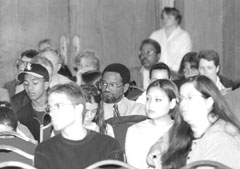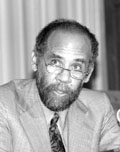The University Record, October 4, 1999 Editor’s Note: The University is defending itself in two lawsuits filed in fall 1997 over the use of race in its admissions processes, one against LS&A and the other against the Law School. Both were brought by the Center for Individual Rights on behalf of white students who were not admitted to the University. Procedural motions will be filed in the spring and they may go to trial next summer. Both are class action suits and each now has a group of intervenors on behalf of the defense. For additional information on the lawsuits, visit the Web at
By Jane R. Elgass

The University is vigorously defending its undergraduate and Law School admissions practices because diversity of the student body is a critical element in a successful college education.
While the United States no longer has “segregation by design,” as it did for many years, “we still are a largely separated country,” Provost Nancy Cantor told an audience of more than 400 in the Michigan Union Ballroom Sept. 29.
“Children grow up largely in different worlds,” she said, and the opportunities made possible by a diverse community within and outside the classroom that the University provides are at the heart of what education is all about.
“Race is a powerful metaphor for crossing experiences,” she noted. College challenges individuals’ presumptions and assumptions, and crossing the boundaries of race and ethnicity is one of the most powerful ways to effect those challenges.
“As educators, as openers of minds, we must take advantage of the psychological readiness” of young people’s minds. “This is one of the few times in the life course when we shed separateness and come together. It is not easy but it is critical to have an institution that facilitates crossing those boundaries.”
Cantor was joined in the program “Affirmative Action: Where Do We Stand?” by Jeffrey S. Lehman, dean of the Law School, and John Payton of the Washington, D.C., law firm of Wilmer, Cutler and Pickering, which is representing the U-M in the lawsuits. Regarded as one of the nation’s leading civil rights attorneys, Payton is the lead attorney in the two cases.

The emphasis that the University places on diversity and accessibility is not new, Cantor noted. U-M President James B. Angell commented in an 1879 commencement address on the responsibility that public universities have in providing a diverse community and the importance of making a college education accessible to all who are qualified.
Then, as now, Cantor noted, education was the road to social and economic mobility. Angell also recognized that a campus of like-minded people would not provide a challenging environment.
A campus peopled by students who are mirror images of themselves would be “incredibly boring,” Cantor said.
Of equal importance, the provost noted, is what we do with our education. “The value of a Michigan education is directly proportional to how far we diffuse the educated values learned on this campus.”
The continuing importance of these points, Cantor emphasized, has been supported by two recent studies. The first, by William Bowen and Derek Bok, showed that students of color graduate in substantial numbers from selective institutions and go on to successful lives.
The second, conducted by psychology Prof. Patricia Gurin, showed that all students benefit by being in a diverse community.
While some have raised the specter of reverse discrimination, Cantor argued that eliminating race-based admissions decisions would come at great cost—to the quality of education for all students, to our quality of life in general, to the economic and social mobility of people of color.
“The returns of higher education in attending a selective institution were never greater than today,” the provost stated. “There are no easy alternatives out there. Socio-economic status is important but is not a proxy if you are interested in creating a diverse class.”
As a result of voter-initiated legislation in California and a court ruling affecting Texas, public universities in those states now are struggling to retain broad applicant pools.

California voters in 1996 approved Proposition 209, barring the use of race and several other factors in public employment, education and contracting. Also in 1996, the U.S. Court of Appeals for the Fifth Circuit ruled that the University of Texas cannot use affirmative action in admissions and financial aid.
In admitting the top 4 percent of high school graduating classes and placing more emphasis on advanced placement classes, Cantor said, Berkeley has moved to basing education policy on housing.
Texas’s practice of automatically admitting the top 10 percent, Cantor fears, will lead to students taking less challenging classes.
Cantor said that while she understands what the institutions are doing and supports their efforts, she finds those solutions are “deeply flawed and costly.”
While the LS&A and Law School cases are separate, at the core they are the same, said Lehman. The plaintiffs claim race-blind admissions are required under the Constitution. “We say they are wrong, based on the law and good academic policy.”
The Law School seeks students who have or will develop good critical and analytical skills, who will be able to argue against themselves better than their opponents can argue. Much coursework is based on discussions, and those discussions are better in a diverse classroom. “We look for students who have the potential to add to the diversity of the class,” Lehman stated. “We do not live in a color-blind society. Race matters still, and in ways relevant to perspectives on the law and the profession. We do not admit students who are unqualified or unable to succeed.”
Lehman said the School’s admissions policy has been vindicated by two recently released studies it has done, one addressing the achievements of graduates since 1970 and the other comparing students at Harvard University and the U-M.
The study of graduates indicated that there is not a statistically significant difference by race in bar passage rates, income or satisfaction with the profession.
Students responding to the comparative study overwhelmingly indicated that a diverse campus had a positive impact on them while in school and that the current policy should be maintained.
“Our admissions policy is an integral aspect of what we are,” Lehman stated. “I’m confident we’ll prevail.”

Payton provided a bit of a historical context for the audience, noting that in 1903 the activist and intellectual William E.B. DuBois said: “The problem of the 20th century is the problem of the color line in relation of the darker to the lighter races in Asia and Africa, in America and the islands of the sea.”
The 1954 Supreme Court decision in Brown vs. Board of Education was thought to signal an end to a divided society, one in which white suppression was seen in every area, Payton said. Brown’s essential promise—integration of K-12 education—“has been almost a total disappointment. Our cities and suburbs are more segregated today than then. At the end of the 20th century, however, racism and its effects are alive and well. This stark racial separation persists and extracts a cost.”
The University admits it uses race as one among many factors in its admissions decisions because it intentionally sees a diverse student body for the critical educational value diversity makes available to all, Payton told the audience.
“Our position is that the cases are controlled by the Supreme Court’s decision in Bakke in 1978. While the Court held against the University of California, Davis, Medical School admissions process, it did say the government has a compelling interest in diversity.”
The Bakke decision, Payton noted, said race can be one element among many. The UC Davis Medical School had set aside 16 seats for minority students and had rigid, separate pools.
“The University’s processes are clearly broad and integrated, taking in a whole range of factors,” Payton explained. “The breadth of our process cannot be questioned. We meet the requirements of Bakke. We can make the case that there is a compelling interest in diversity, that students in higher education learn better and are better prepared to contribute to our democratic society” if they can study in a diverse environment.
Payton said he does not believe actions by courts and citizens in other states will affect decisions in the U-M cases.
A recent ruling in Virginia against a kindergarten program “will not control the outcome of the University’s cases,” Payton said. Likewise, the voter actions in California and Washington state, banning consideration of race and gender in hiring and education, “have no impact outside those states.”
“Bakke is still good law and should control the outcome of this case.”

